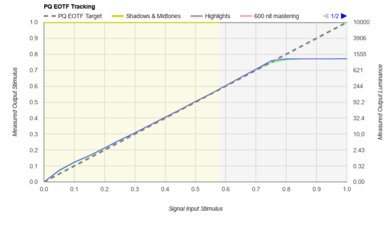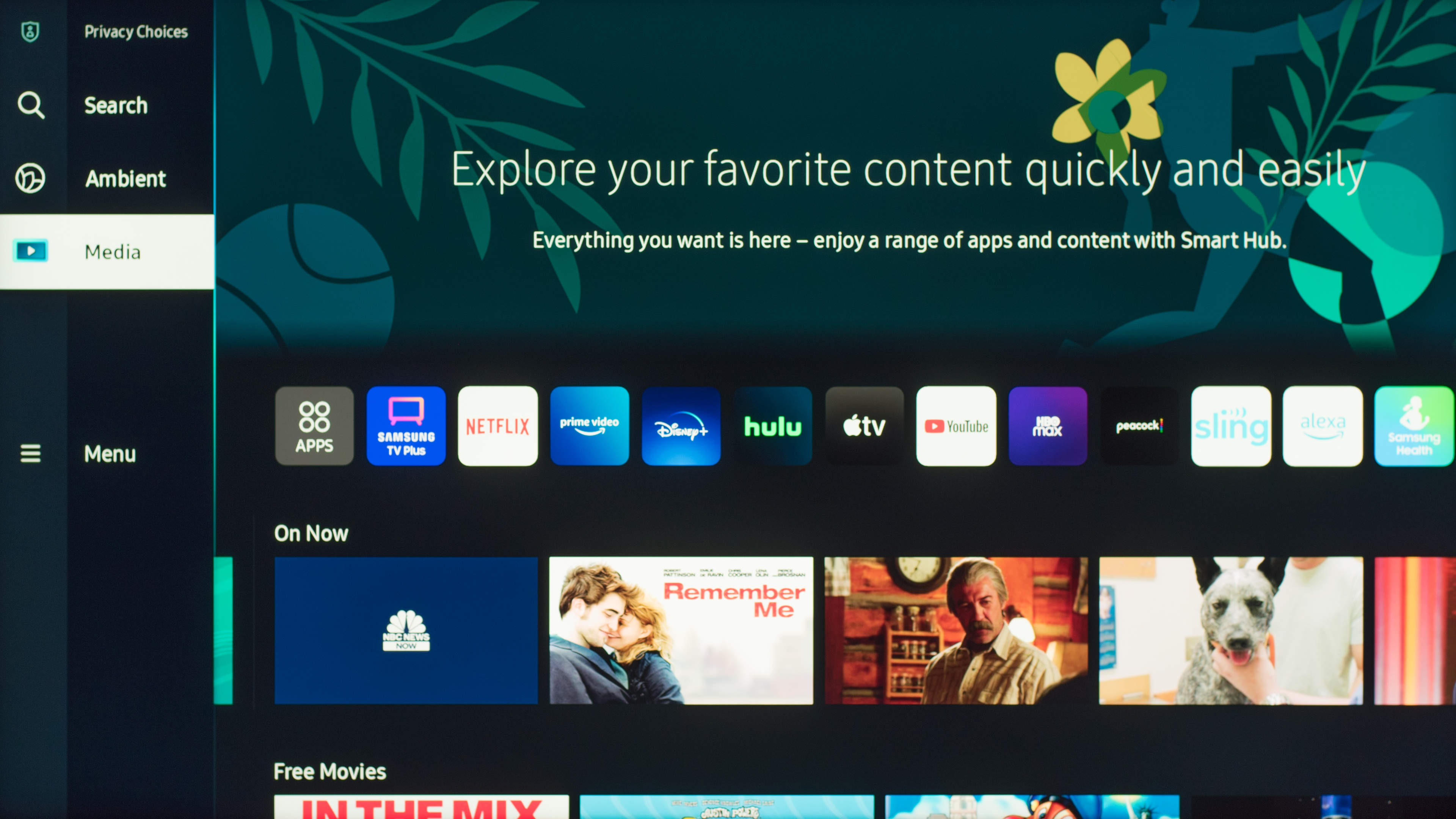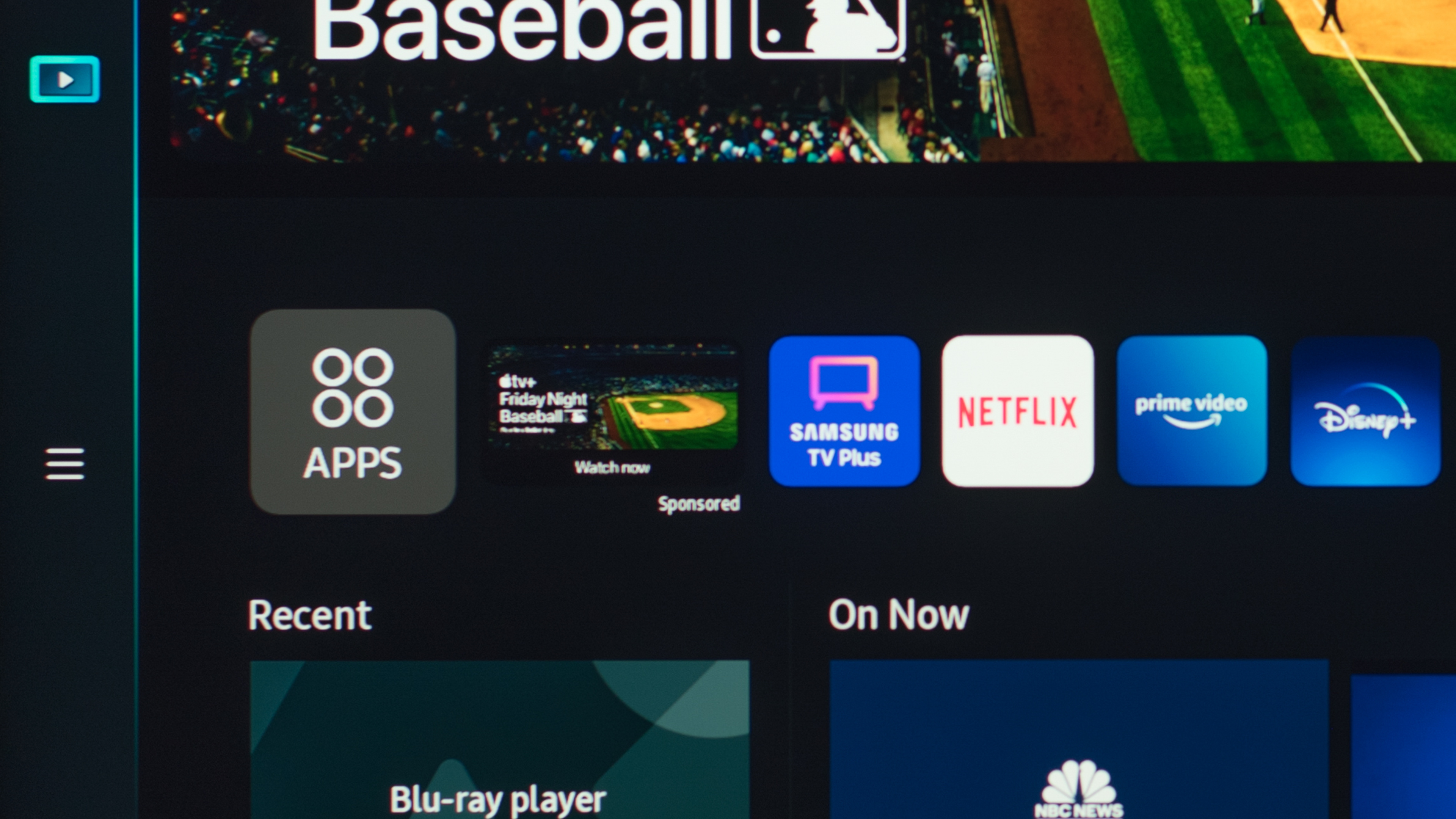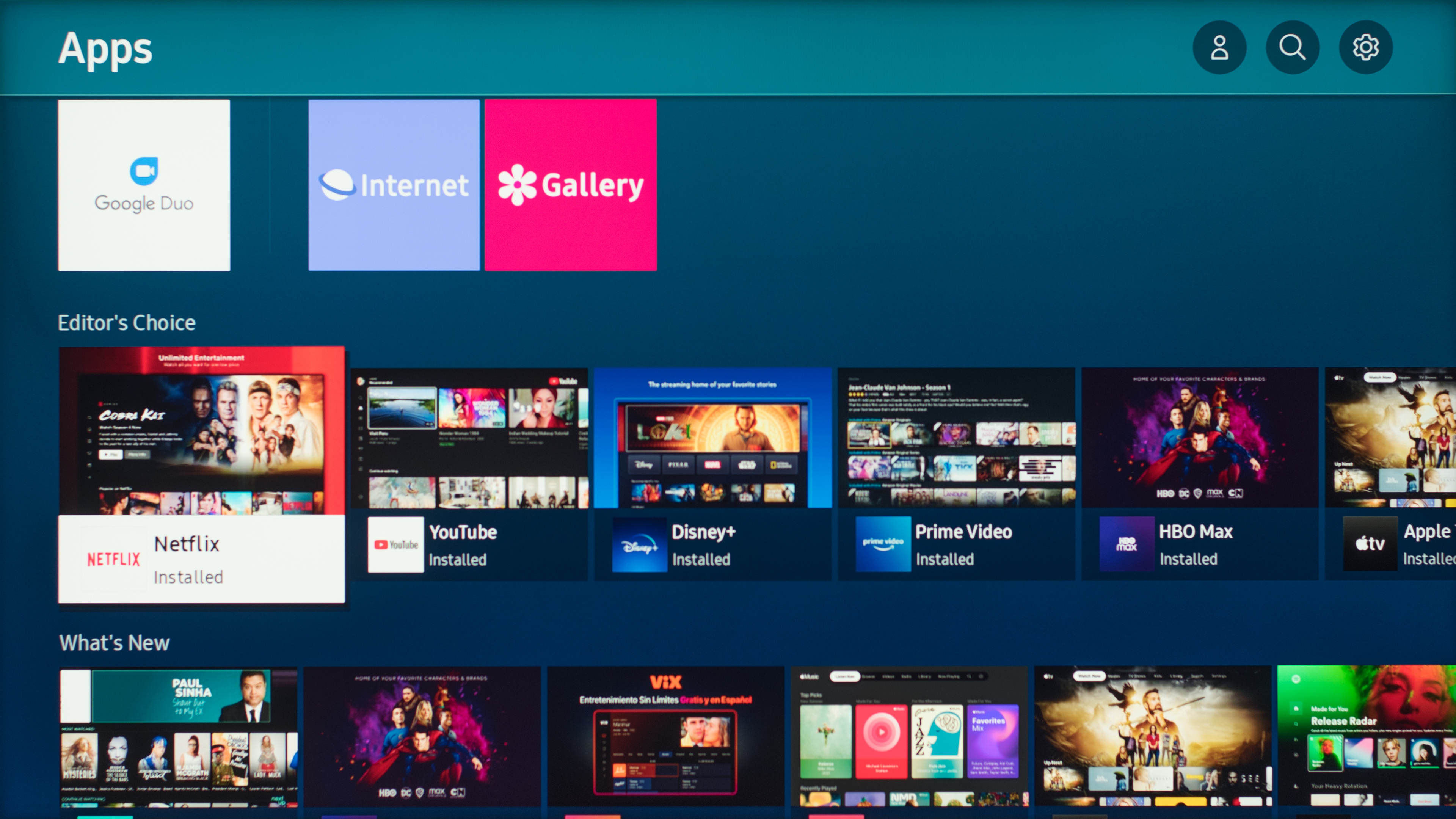
Samsung releases a fair share of new models every year, so if you find yourself searching the internet for the best Samsung televisions, you might become overwhelmed by the amount of options. We buy and test dozens of TVs each year, and we've reviewed over 130 Samsung TVs, so we can help narrow down your options to find the best Samsung television for your needs and budget.
Generally speaking, Samsung TVs are versatile and can provide good-to-excellent picture quality. Samsung is known for its LED models, which generally have great gaming features. Samsung introduced their new Neo QLED TV lineup in 2021, which is an improvement on their more traditional QLED lineup as it introduces Mini LED backlighting. When combined with the quantum dot layer, their high-end TVs provide great picture quality. Along with Sony, they also released the first QD-OLED TV in 2022 to compete with LG's OLED lineup.
You can vote on which Samsung TVs you want us to buy and test, or check out our 2025 TV lineup page.
Updates
- 06/11/2025 Samsung QN990F 8K reviewed
- 06/02/2025 Samsung S90F OLED reviewed
- 05/13/2025 Samsung S95F OLED reviewed
- 05/02/2025 Samsung QN90F reviewed
- 04/29/2025 Samsung S85F OLED reviewed
-
Best Samsung TV
Mixed Usage8.5Home Theater8.7Bright Room7.2Sports7.6Gaming9.0Performance Usages: Brightness7.8Black Level10Color8.9Processing (In Development)8.0Game Mode Responsiveness9.3Motion Handling (Broken)7.9Resolution 4kNative Refresh Rate144HzScreen FinishGlossyType OLEDSub-TypeQD-OLEDDolby VisionNoSizes 42" (WOLED) 48" (WOLED) 55" (QD-OLED) 65" (QD-OLED) 77" (QD-OLED) 83" (WOLED)The Samsung S90D/S90DD OLED (QD-OLED) is the best Samsung TV. Like any OLED TV, you get unrivaled black levels for deep, inky blacks in a dark room. Since it uses a QD-OLED panel, you also get incredibly vibrant, lifelike, and bright colors that can't be matched by traditional WOLED displays. It's also brighter than many other OLEDs, so you can use it in a well-lit room and won't be distracted by reflections on the screen. Just make sure you get one with a QD-OLED panel.
It's loaded with modern gaming features like HDMI 2.1 bandwidth, 4k @ 144Hz, and VRR support, making it a great option for pairing with modern consoles and gaming PCs. It also has one of the fastest response times on the market, so motion is crisp and clear. In addition to that, it has exceptionally low input lag, so you don't notice a delay between the actions on your controller and the actions on the screen.
There's also the higher-priced Samsung S95D OLED, which differentiates itself from the S90D in two ways. It uses Samsung's external Slim One Connect Box, which offers a versatile solution for those who need quick access to the TV's ports when the TV is wall-mounted. It also uses a unique matte screen coating that does an amazing job of eliminating reflections in the brightest rooms, but it does so at the cost of picture quality. If those features sound enticing, it might be worth spending extra on the S95D, but for most people, the S90D is the better option.
-
Best Upper Mid-Range Samsung TV
Mixed Usage8.1Home Theater8.2Bright Room8.5Sports8.4Gaming7.6Performance Usages: Brightness9.1Black Level8.6Color7.8Processing (In Development)7.4Game Mode Responsiveness7.2Motion Handling (Broken)7.7Resolution 4kNative Refresh Rate144HzScreen FinishGlossyType LEDSub-TypeVADolby VisionNoSizes 43" 50" 55" 65" 75" 85" 98"The Samsung QN90D/QN90DD QLED is one of the best Samsung TVs in the upper mid-range category we've tested. It's an incredibly bright TV with fantastic reflection handling, making it a great choice for living rooms during sunny days. Although it doesn't display the same inky blacks as the Samsung S90D/S90DD OLED, its stellar local dimming delivers deep blacks in a dark room with minimal blooming. In addition to that, it's a very colorful TV, so you get vibrant and bright colors that really pop out at you. Unfortunately, it doesn't have a wide viewing angle like the OLED does, although it's not bad for an LED TV.
Regarding gaming, this TV is loaded with modern gaming features like HDMI 2.1 bandwidth on all four ports for up to 4k @ 144Hz gaming with VRR. Its input lag isn't quite as low as it is on the QD-OLED, but it still provides an incredibly responsive gaming experience. The TV's response time isn't as fast either, but it's still quick enough for minimal blur behind fast motion, although it does struggle more with coming out of dark states, so you do notice some black smearing in dark scene transitions.
-
Best Mid-Range Samsung TV
Mixed Usage7.5Home Theater7.5Bright Room7.9Sports7.9Gaming7.2Performance Usages: Brightness8.0Black Level7.3Color7.5Processing (In Development)7.7Game Mode Responsiveness7.2Motion Handling (Broken)7.6Resolution 4kNative Refresh Rate120HzScreen FinishGlossyType LEDSub-TypeVADolby VisionNoSizes 55" 65" 75" 85"If you like the Samsung QN90D/QN90DD QLED but find it too pricey, you can step down to the mid-range Samsung QN85D/QN85DD QLED. It has similar black levels as the more expensive QLED, so you still get deep blacks in a dark room, although there's a bit more blooming. It's not as bright as the QN90D, and its reflection handling is worse, but it's still good enough to use in a bright room and not be distracted by glare on the screen. Like the more expensive QLED, it displays vibrant colors that are sure to impress, but it does struggle more with displaying those colors brightly. Unfortunately, its viewing angle is very narrow, and you need to be centered in front of the screen to enjoy the best possible picture quality. This makes it a poor choice for watching TV with a large group.
The TV has HDMI 2.1 bandwidth on all four of its ports, but unlike the two picks above, they're limited to 120Hz. Still, it has VRR support, so it's a great option if you're looking to get the most out of your modern consoles. You also get similarly low input lag as the QN90D, but its response time is slower, so you do see more blur behind fast motion.
-
Best Lower Mid-Range Samsung TV
Mixed Usage7.9TV Shows7.4Sports7.4Video Games8.3HDR Movies8.2HDR Gaming8.3PC Monitor8.2Resolution 4kNative Refresh Rate120 Hz (except 50")Screen FinishSemi-glossType LEDSub-TypeVADolby VisionNoSizes 50" 55" 65" 75" 85"If you want a Samsung TV without breaking the bank, the Samsung Q80D QLED is the best lower mid-range Samsung TV we've tested. Its reflection handling isn't quite as good as the Samsung QN85D/QN85DD QLED, but its equally impressive SDR brightness means it still overcomes glare in a well-lit room. Its black levels aren't as good as the QN85D, and its colors aren't as vibrant, but it provides a good dark room experience, and colors still pop. Like the QN85D, it has a narrow viewing angle that limits its usefulness in a group setting.
Although the TV doesn't look as good as the picks above, it still has modern gaming features that make it pair well with modern consoles. You still get HDMI 2.1 bandwidth, 4k @ 120Hz, and VRR. Its input lag is on par with the QN85D, so you also still get a responsive gaming experience, but its slower response time means you do see more blur behind fast motion.
-
Best Budget Samsung TV
Mixed Usage5.8Home Theater5.8Bright Room6.4Sports6.3Gaming5.6Performance Usages: Brightness5.7Black Level5.0Color6.2Processing (In Development)6.2Game Mode Responsiveness5.6Motion Handling (Broken)6.9Resolution 4kNative Refresh Rate60HzScreen FinishGlossyType LEDSub-TypeVADolby VisionNoSizes 32" 43" 50" 55" 65" 70" 75" 85"The Samsung Q60D is the best budget Samsung TV we've tested. Although Samsung doesn't release many budget models anymore, this TV offers decent overall performance at a lower cost than their more expensive models. It's not as bright as the Samsung Q80D QLED, but its reflection handling is the same, so it still overcomes glare in rooms with a few lights on. Unfortunately, it doesn't have a local dimming feature, so blacks are grayish most of the time. The TV displays vibrant colors, but it doesn't display colors very brightly. It also has a very narrow viewing angle, so it's best viewed from directly in front of the screen.
Unfortunately, it's not nearly as good for gamers as the picks above, as it's pretty bare-bones when it comes to gaming features. It only has HDMI 2.0 bandwidth, is limited to 4k @ 60Hz, and doesn't have VRR support. Its input lag is low enough for a responsive gaming experience, but its response time is slow, so fast motion is blurry. If you're looking for a TV to take advantage of your modern console, the Q60D isn't a great option, but it's not bad overall for watching content.
Compared To Other Brands
-
Well-rounded.
Samsung's high-end models are some of the best TVs we've tested. They don't excel in just one category; they're well-rounded and offer great performance for various uses. -
Perform well in dark and bright environments.
Their QLED TVs, especially those with VA panels, have high contrast and get bright, so they're good for dark and bright rooms. -
Great gaming features.
Samsung is a leader in gaming features, and even their mid-range models have variable refresh rate (VRR) and ALLM support.
-
Uniformity issues.
Samsung models typically don't have the best gray uniformity and have some dirty screen effect, which could get distracting during sports or PC use. -
TVs can be costly, and may not offer good value.
Samsung's high-end TVs can get costly, so while they provide the best performance, they may not have the best value compared to other brands. There are often cheaper TVs that you can get with no compromises. -
Few budget models.
Although Samsung used to offer a wide range of budget models, in recent years, they've really scaled down their budget lineup. Their budget models typically aren't worth buying when you can get better picture quality and performance from companies like Hisense and TCL. -
No Dolby Vision or DTS audio support.
Although Samsung has their own dynamic HDR format in HDR10+, none of their TVs support the more widely used Dolby Vision format. They also don't include support for advanced DTS audio formats, which are prevalent in physical media.
Samsung vs Sony
Samsung TVs usually have more gaming features than Sony TVs, in particular, lower input lag and official 4k @ 144Hz on some models, and Samsung also has a bigger TV lineup. In comparison, Sony TVs are usually built a bit better, with mostly metal construction. They also tend to have better image processing and color accuracy, so they're better for home entertainment setups, especially as Sony typically supports Dolby Vision HDR and advanced DTS audio formats.
Samsung vs LG
Samsung TVs generally have better picture quality than the average LG LED-backlit TV. Samsung TVs usually get a fair bit brighter and have better contrast, while LG TVs generally have much wider viewing angles and better smart features. While LG was one of the first companies to offer OLED displays and has a few popular models to choose from, Samsung has caught up with their OLED offerings. They offer OLEDs that use the same WOLED panel found in LG's OLEDs, but they also offer QD-OLEDs, which produce brighter and more vibrant colors. LG OLEDs tend to have a bit more features than Samsung's, like support for Dolby Vision HDR and DTS audio formats. LG also has slightly better image processing than competing Samsung models.
Samsung vs Hisense
Hisense TVs have better value than Samsung TVs, as their TVs tend to be a fraction of the price for equal, and sometimes even better, performance. However, Hisense doesn't have any TVs to compete with Samsung's OLEDs, and their TVs tend to have bugs and quirks that Samsung's products don't have. Plus, Hisense TVs tend to have a narrow viewing angle, so they're not as well suited for wide seating arrangements.
Samsung vs TCL
TCL TVs are a better value than Samsung TVs, as they offer comparable or better performance for a fraction of the price. Like with Hisense, TCL has no models to compete with Samsung's OLEDs, and their TVs have more bugs and quirks than Samsung's. TCL TVs also have a narrow viewing angle, so they're not optimal for wide seating arrangements.
Samsung TVs provide performance suitable for most buyers, but they can also be costly compared to some competing brands. They generally perform very well and are among the best TVs on the market, especially if you want gaming features. However, competition is increasing, and Samsung LED TVs don't provide as much value as they previously did. On the other hand, their OLED TVs are some of the best on the market and compete with high-end LG OLED models.
2025 Samsung Lineup
Samsung announced their new 2025 lineup at CES in early January 2025. There's no official date for the release of the new models, but Samsung typically releases them in March. Although Samsung's main focus was on the new AI features that are coming to most of their 2025 models, there are still some other upgrades and new features for their upcoming models.
OLED
Samsung announced their three new OLED models for 2025, all of which are new iterations of their 2024 lineup. The entry-level OLED is the Samsung S85F, which is a minor upgrade over their 2024 Samsung S85D OLED. This model uses a WOLED panel and is available in 42"-83" sizes. We don't know the exact specifications for this model, but we expect it to be an incremental upgrade overall.
In the middle of Samsung's OLED lineup is the Samsung S90F, which is the 2025 version of the popular Samsung S90D OLED. Unfortunately, Samsung will be using both WOLED and QD-OLED panels for the S90F lineup, so the dreaded panel lottery will once again be back in 2025, and you could get either panel technology depending on which size you buy and which region you're in.
The Samsung S95F is the replacement for the Samsung S95D OLED and is their flagship model for 2025. Samsung is switching to a 5-layer tandem OLED stack for this model, which is supposed to greatly increase the overall peak brightness and color volume. Like the S95D, this high-end TV utilizes a matte screen coating, but the coating has been upgraded to Glare Free 2.0 for 2025. Another upgrade is the TV's support for 165Hz, up from 144Hz on the 2024 model.
8k LED
Samsung is one of the only brands left still releasing 8k models, and that hasn't changed in 2025. Samsung is expanding the usage of their matte screen coating to their two 8k models for 2025. Their entry-level 8k TV, the QN900F, is a Mini LED model with support for up to 120Hz gaming. On the other hand is the Mini LED QN990F, which offers a whopping 8k @ 165Hz and 4k @ 240Hz. Furthermore, the QN990F utilizes Samsung's external One Connect Box, while the Q990F doesn't.
4k LED
Four new Mini LED models have been announced—the QN90F, QN80F, QN70F, and The Frame Pro. Although we have limited information on these models, they all seem like marginal improvements over their predecessors. The QN90F uses a matte screen coating and is advertised as supporting 4k @ 165Hz, but we don't know the exact screen coatings and refresh rates for the QN70F and QN80F.
We expect most of Samsung's 4k LED 2025 lineup to be very similar to 2024, but The Frame Pro is certainly quite different. This stylish TV has more in common with Samsung's QNED lineup than previous generations of The Frame TV, with a Mini LED backlight and 144Hz refresh rate. As great as that sounds, there's a major catch here. That Mini LED backlight consists of a single strip of LEDs along the bottom edge, making it an edge-lit model. It's very unlikely that this TV will deliver anything close to good local dimming, and our testing has shown that edge-lit TVs don't last as long, so it seems like a strange decision on Samsung's part.
MicroLED
Samsung has been talking about its Micro LED technology for a few years now. During CES 2025, Samsung unveiled a yet-to-be-named 98-inch 8k model with an RGB Micro LED backlight. This new technology is supposed to offer better color vibrancy, increased brightness, and even finer control of local dimming zones. Samsung has said that this new model might be available in smaller sizes, and although it's still in its prototype stage, they're hoping to release it sometime in 2025. This TV will likely have an incredibly hefty price tag that puts it out of reach for normal consumers, but it could offer us a glimpse into the next breakthrough in panel technology.
Product Naming
Samsung's lineup covers everything from budget to high-end models. As a rule of thumb, the higher the number, the better it is, although sometimes the improvements aren't worth it. Samsung releases four main TV lineups, and they use a consistent naming scheme for the top three lineups, which makes it very easy to understand what you're buying simply by looking at the model number.
Samsung uses the prefix 'Q' to denote their mid-range QLED models, and the last letter of these models also reflects the model year. They introduced the Mini LED lineup in 2021, denoted by the prefix 'QN' in the model name, like the Samsung QN90D. Their entry-level non-QLED models follow a slightly different naming structure; the prefix letters denote the year. For example, the CU8000 is the 2023 entry-level model, and the 2024 models follow the DU*000 naming scheme.
Smart Features
In the infancy of smart TVs, Samsung was the leader in functionality and smart features. It isn't to say that they were very good, as it took quite a few years for Smart TV platforms to mature into something comparable to external set-top boxes. However, other companies have caught up to Samsung and offer similar all-around performance, like Roku TV or LG's webOS, meaning the best Samsung smart TV isn't much better than smart TVs from other brands.
Samsung has constantly been updating its Tizen platform to ensure it competes with its competitors. In 2017, they added voice capabilities to their remote and smart platform, making it easier to navigate through menus. In 2018, they added Bixby virtual assistant, so you can use voice to control other Samsung devices in your house, like lights, fridges, and door locks. The 2020 update featured a new, sleeker look with a 'Dark Mode' that isn't as bright as the white theme in older versions, and the 2022 version added a new full-screen webpage, which is an improvement over past versions that had all the apps and settings in a toolbar.
Interface
The interface is very simple and easy to navigate. Since 2022, Samsung has had a full-screen webpage instead of the toolbar they had in past years. You'll find downloaded apps here, and you can quickly access the different inputs and settings. The interface works well, and there are many animations, but these can be slower on lower-end TVs.
Ad-free
Unfortunately, Samsung's Smart Hub also shows ads on the home screen. They appear in the same row as the installed Samsung Smart TV apps, and you can't disable them.
You can opt out of personalized advertising in the settings, but unfortunately, that only means that you'll see very repetitive ads instead of targeted ones.
Apps & Features
The app selection is pretty extensive nowadays. All the popular video and music services are available. Fortunately, the search function is quite good, and results come up very quickly. Like LG's webOS and Google TV on Sony TVs, Samsung TVs have an excellent selection of apps, and all major streaming services are available.
Voice Controls
Samsung overhauled Voice Command in 2017, and voice controls are pretty good now. They updated other smart interfaces in 2018 to search for content and apps and change settings, which is something Samsung has been able to do for a few years. Even more in-depth stuff like calibration settings are only a button press away, which is quite nice.
- Changing inputs
- Launching apps
- Basic online searches, including "What time is it?" or "How's the weather in New York?"
- Changing some settings
It's also possible to search within apps, but only a few apps support this.
Recent Updates
-
Rewrote the Samsung Lineup section to include information on their 2025 models.
-
Replaced the Samsung Q80C QLED with the Samsung Q80D QLED in the 'Best Lower Mid-Range Samsung TV' category. We also refreshed some text throughout for clarity.
-
Aug 23, 2024 : With the exception of the Samsung Q80C QLED, we replaced every TV with the 2024 equivalents. We also updated text throughout to bring more clarity to our picks and to make the article up to date.
-
Jun 27, 2024 : Confirmed that our picks are still widely available and refreshed some text for accuracy.
-
May 28, 2024 : Refreshed text throughout the article for accuracy and clarity.
Conclusion
Samsung, in general, makes very good TVs. Their range has increased in price, but most people will still find a TV that suits their needs. Their smart features could be better, but they're still quite good. They're usually quite versatile and fit most uses. You might have to pay a premium for their TVs, but you'll get excellent picture quality, especially with the higher-end models. Ultimately, if you're looking for the best Samsung model for your needs, you're sure to find great picture quality. If you want more detailed information on their models, you can find a list of our recent Samsung TV reviews below.
Test Results
Comments
Best Samsung TVs: Main Discussion
What do you think of our picks? Let us know below.
Looking for a personalized buying recommendation from the RTINGS.com experts? Insiders have direct access to buying advice on our insider forum.
We’ve just released a new video that mentions the Samsung S95F OLED here.
- 21010
So it appears that Samsung did away with the Q60 series TV’s for 2025 and now the QN70 series seems to be their entry level QLED series.












![Samsung Q80D [Q80, Q80DD] QLED Design Picture](https://i.rtings.com/assets/products/Z93g1IfV/samsung-q80d-q80-q80dd-qled/design-small.jpg?format=auto)
![Samsung Q80D [Q80, Q80DD] QLED In-Test Picture](https://i.rtings.com/assets/products/yRRGyQMI/samsung-q80d-q80-q80dd-qled/in-test-small.jpg?format=auto)
![Samsung Q80D [Q80, Q80DD] QLED PQ EOTF Graph](https://i.rtings.com/assets/products/I1cLokUG/samsung-q80d-q80-q80dd-qled/pqeotf-graph-small.jpg?format=auto)
![Samsung Q80D [Q80, Q80DD] QLED Pre Color Picture](https://i.rtings.com/assets/products/rUrtaIxh/samsung-q80d-q80-q80dd-qled/pre-colorspace-small.jpg?format=auto)





















































